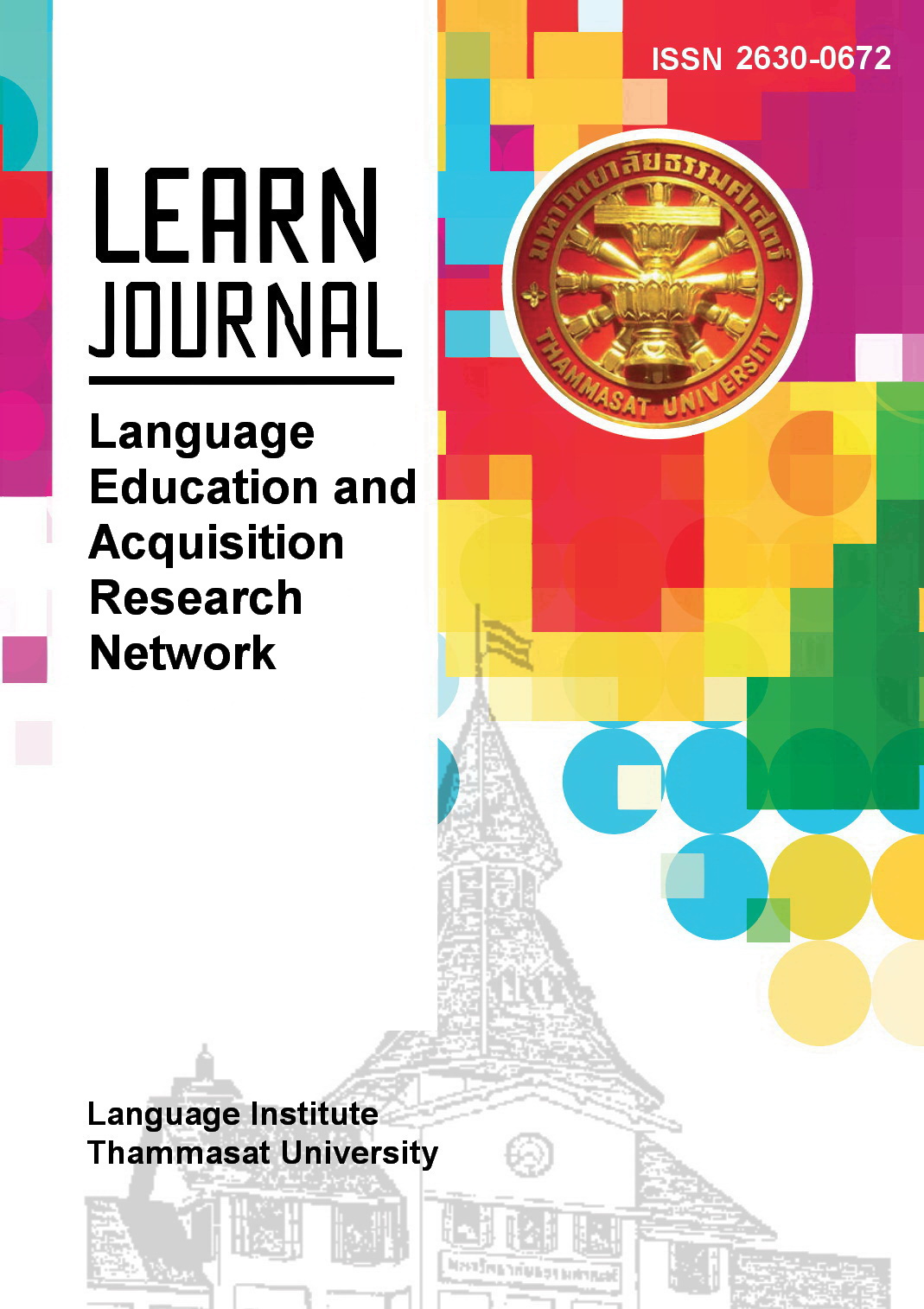Analysis of Collocations and Semantic Preference of the Near-synonyms: Blank, Empty, and Vacant
Main Article Content
Abstract
For English language learners, mastering the use of near-synonyms can be challenging. Despite the semantic similarities of English synonyms, they are not interchangeable in all contexts. The objectives of this corpus-based study are to examine differences between the near-synonymous adjectives blank, empty and vacant based on the degree of formality from their distribution across genres and to analyze the noun collocates in relation to semantic preference drawn from the Corpus of Contemporary American English (COCA). The findings indicate that these synonyms are uncommon in formal English, i.e., academic texts and they tend to have quite different occurrences and distributions across genres (i.e., blank and empty most frequently occur in fiction whereas vacant mostly occurs in newspaper) despite a similar degree of formality. For the noun collocates and semantic preference, these three adjectives have a weak near-synonymous status as they share only one noun collocate and one similar theme of semantic preference. Thus, despite their similarity in meanings, these synonyms co-occur with specific noun collocates in a particular context.
Article Details
References
Bailey, A. L. (2007). The language demands of school: Putting academic English to the test. Yale University Press.
Cai, J. (2012). Is it “great” enough? A corpus-based study of “great” and its near synonyms (Publication No. 161807978) [Master’s thesis, Ball State University]. Semantic Scholar.
Cambridge dictionary. (Online). https://dictionary.cambridge.org/
Cheng, W. (2012). Exploring corpus linguistics: Language in action.
Routledge.
Clark, E. V. (1992). Conventionality and contrast: Pragmatic principles with lexical consequences. In A. Lehrer & E. F. Kittay, (Eds.), Frames, fields, and contrasts: New essays in semantic and lexical organization (pp.171–188). Lawrence Erlbaum.
Collins dictionary. (Online). https://www.collinsdictionary.com
Crawford, W. J., & Csomay, E. (2016). Doing corpus linguistics. Routledge.
Cruse, D. A. (1986). Lexical semantics. Cambridge University Press.
Davies, M. (2020). The corpus of contemporary American English. English corpora. https://www.english-corpora.org/coca
DiMarco, C., Hirst, G., & Stede, M. (1993, March 25). The semantic and stylistic differentiation of synonyms and near-synonyms [Address]. AAAI Spring Symposium on Building Lexicons for Machine Translation, Stanford, USA. https://www.aaai.org/Papers/Symposia/ Spring/1993/SS-93-02/SS93-02-025.pdf
Edmonds, P., & Hirst, G. (2002). Near-synonymy and lexical choice. Computational Linguistics, 28(2), 105-144. https://doi.org/10.1162/089120102760173625
Firth, J. R. (1957). A synopsis of linguistic theory 1930-55 in studies in linguistic analysis, philosophical society. Longman.
Flowerdew, J. (2012). Corpora and language education. Palgrave
Macmillan.
Gablasova, D., Brezina, V., & McEnery, T. (2017). Collocations in corpus-based language learning research: Identifying, comparing, and interpreting the evidence. Language Learning, 67(1), 155-179. https://doi.org/10.1111/ lang.12225
Gilquin, G. (2020). Learner corpora. In M. Paquot & S. Gries (Eds), A practical handbook of corpus linguistics (pp. 283-303). Springer.
Gu, B. J. (2017). Corpus-based study of two synonyms ‘obtain’ and ‘gain’. Sino-US English Teaching, 14(8), 511–522. https://dx.doi.org/10.17265/1539-8072/2017.08.006
Hunston, S. (2007). Using corpus to investigate stance quantitatively and qualitatively. In R. Englebretson (Ed.), Stance taking in Discourse (pp. 27-48). John Benjamins.
Jackson, H., & Amvela, E. Z. (2007). Words, meaning, and vocabulary: Introduction to modern lexicology. Bloomsbury.
Jirananthiporn, S. (2018). Is this problem giving you trouble? a corpus-based examination of the difference between the nouns ‘problem’ and ‘trouble’. Thoughts, 2, 1–25. https://so06.tci-thaijo.org/index.php/thoughts/article/view/163389
Kruawong, T., & Phoocharoensil, S. (2022). A genre and collocational analysis of the near-synonyms teach, educate and instruct: A corpus-based approach. TEFLIN Journal, 33(1), 75-97.
Laufer, B. (1990). Ease and difficulty in vocabulary learning: Some teaching implications. Foreign Language Annals, 23(2), 147–155. https://doi.org/10.1111/j.1944-9720.1990.tb00355.x
Lewis, M. (2000). Teaching collocation: Further development in the lexical approach. Heinle & Heinle.
Li, E. (2019). A corpus-assisted study of synonyms in EFL teaching: Take preserve and conserve as example. Linguistics and Literature Studies. 7(2), 39-50. https://doi.org/10.13189/lls.2019. 070201
Lindquist, H. (2009). Corpus linguistics and the description of English. Edinburgh University Press.
Liu, D. (2013). Salience and construal in the use of synonymy: A study of two sets of near synonymous nouns. Cognitive Linguistics, 24, 67–113. https://doi.org/10.1515/cog-2013-0003
Liu, D., & Espino, M. (2012). Actually, genuinely, really, and truly: A corpus-based behavioral profile study of near-synonymous adverbs. International Journal of Corpus Linguistics, 17(2), 198-228. http://doi.org/10.1075/ijcl.17.2.03liu
Longman Dictionary of Contemporary English. (Online). https://www.ldoceonline.com
Murphy, M. L. (2010). Lexical meaning. Cambridge University Press.
Norris, C. B. (2016). Academic writing in English. University of
Helsinki.
O'Dell, F., & McCarthy, M. (2008). English collocations in use: Advanced. Cambridge University Press.
Oxford advanced learners’ dictionary. (Online). https://www.oxfordlearnersdictionaries.com/
Palmer, F. (1981). Semantics (2nd ed.). Cambridge University Press.
Partington, A. (2004). Utterly content in each other’s company: Semantic prosody and semantic preference. International Journal of Corpus Linguistics, 9, 131-156. https://doi.org/10.1075/ijcl.9.1.07par
Petcharat, N., & Phoocharoensil, S. (2017). A corpus-based study of English synonyms: Appropriate, proper, and suitable. LEARN Journal: Language Education and Acquisition Research Network, 10(2), 10-24.
Phoocharoensil, S. (2010). A corpus-based study of English synonyms. International Journal of Arts and Sciences, 3(10), 227-245.
Phoocharoensil, S. (2020). A genre and collocational analysis of ‘consequence’, ‘result’, and ‘outcome’. 3L: Language, Linguistics, Literature. The Southeast Asian Journal of English Language Studies, 26(3), 1-16. https://doi.org/10.17576/3L-2020-2603-01
Phoocharoensil, S., & Kanokpermpoon, M. (2021). Distinguishing the near-synonyms ‘increase’ and ‘rise’: Genre and collocation investigation. Kasetsart Journal of Social Sciences, 42(4), 968-975. https://doi.org/10.34044/j.kjss.2021.42.4.34
Schmitt, N. (2010). Researching vocabulary: A vocabulary research manual. Springer.
Selmistraitis, L. (2020). Semantic preference, prosody and distribution of synonymous adjectives in COCA. Journal of Language Studies, 20(3), 1-18. http://doi.org/10.17576/gema-2020-2003-01
Sinclair, J. (1996). The search for units of meaning. Textus, 9(1), 75-106.
Szudarski, P. (2018). Corpus linguistics for vocabulary: A guide for research. Routledge.
Timmis, I. (2015). Corpus linguistics for ELT: Research and practice.
Routledge.
Vicentini, A. (2003). The economy principle in language notes and observations from early modern English grammars. Mots Palabras Words, 3(2003), 37-57. https://www.mediensprache.net/archiv/ pubs/3659.pdf
Webb, S. (2007). The effects of synonymy on second-language vocabulary learning. Reading in a Foreign Language, 19(2), 120–136.
Xiao, R., & McEnery, T. (2006). Collocation, semantic prosody, and near synonymy: A cross-linguistic perspective. Applied Linguistics, 27(1), 103–129. https://doi.org/10.1093/applin/ami045


